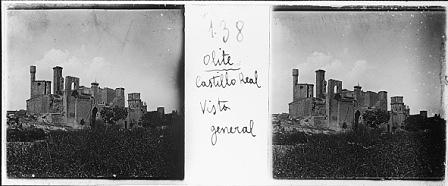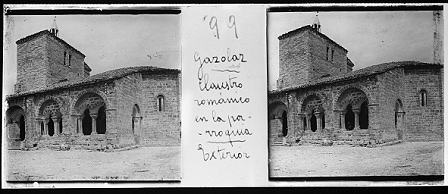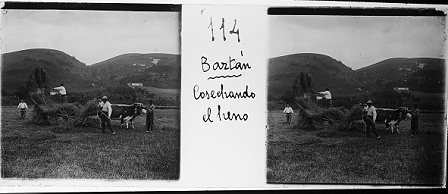The piece of the month of July 2012
STEREOSCOPIC VIEWS OF NAVARRA, BY CELESTINO MARTÍNEZ LÓPEZ-CASTRO
Félix Segura Urra
file Royal and General of Navarra
The collection of stereoscopic views of Navarre, currently consisting of 67 glass plates and two viewing devices, constitutes one of the most unique photographic sets guarded by the file Real y General de Navarra. Its past celebrity, derived from the echoes of the Ibero-American exhibition of Seville in 1929, was felt for decades in the entrance hall of the former headquarters of file, where the stereoscopes remained exposed and operational for the amusement and curiosity of researchers and visitors. To this day, the unknowns about its authorship and the evaluation of its fitting in the exhibition speech of the Pavilion of Navarre deserve some brief clarifications.
The Regional Council designated a committee for the organization of Navarre's participation in the Ibero-American exhibition in which a series of ideas, projects and intellectual interests converged, placing photography as a fundamental tool for the transmission of the image of modernization, dynamism and patrimonial wealth that was intended to be associated with Navarre. In this sense, among the decisions of the committee, leaving aside the best known of subject logistical, constructive or exhibition related to the Pavilion of Navarre, it is worth mentioning the publication of guide Turística de Navarra in 1929, the "Navarra Artística" postcard pads, the Catalog of the Pavilion of Navarre or the subsidies that contributed to the publication of the Casa Navarra de Leoncio Urabayen and the Libro de Oro de la exhibition Iberoamericana of Seville. Some of these projects came from a previous impulse by the committee Provincial Tourism Office, which since 1921 had been operating under the aegis of the Provincial Council ( board of trustees ).
This iconic program devised by the committee, with a broader scope, could be glimpsed in the exhibition speech itself, which was temporarily and ephemerally displayed in the Pavilion of Navarre through a varied collection of photographs of landscapes, monuments, customs and costumes of Navarre. The decision to adopt photography as an exhibition element was a specific commitment of committee, in which the position of its president and secretary, the foral deputy Francisco Javier Arraiza and the provincial archivist José María de Huarte y de Jáuregui, respectively, should be valued. Regarding the latter, suffice it to recall his performance as secretary of the Regional Costume Commission that in 1924 commissioned José Roldán to take the photographs for the exhibition of the Regional Costume, as well as his later interlocution with the main photographic programs of study of Barcelona for the edition of the mentioned postcards -Lucien Roisin's studio- or even in 1932 as secretary of the committee of Culture of Navarre for the acquisition of an important batch of photographs -Arxiu Mas- that completed those already bought in 1916 in what came to be called the "Iconographic Repertoire of Navarre".

Sartaguda. Boat on the Ebro
The photographs for the Navarre Pavilion in Seville, which was set up as an authentic showcase for the province, were exhibited in the second of its three main rooms. Inside, the section dedicated to Agriculture included a brief selection of traditional images by José Roldán from exhibition of the Regional Costume held in 1925. The section dedicated to Tourism was integrated in its entirety by the collection of stereoscopic views of monuments, archeology and landscapes of Navarre commissioned to Celestino Martínez López-Castro, originally formed by 150 glass plates with its three stereoscopic devices.
Celestino Martínez López-Castro was an amateur photographer of Tudela origin and military profession. At the time he was commissioned by the Commission of Navarra, he was already known for his important private photographic collection. As is the case with so many other amateur photographers, he was never part of the cast of fundamental authors for the development of Navarre photography, but he was an active participant in it. The designation of an amateur photographer to illustrate the image of Navarre may have been due to certain personal connections with the members of committee. Celestino Martínez López-Castro was at that time captain of infantry of the regiment of the Constitution, but he had also been captain of the regiment of Cantabria and had previously belonged to the garrison of Pamplona. Not in vain, his interlocutor at all times was the secretary of committee, José María de Huarte y de Jáuregui, as a good military man - specifically an artillery officer - and a great connoisseur of private collections in Navarre.

Olite. Royal Castle. General view
The versatility of Celestino Martínez López-Castro's collection acted in consonance with the destination and public to which its exhibition was directed. The set brought together a double facet, the figurative testimony of the rich heritage and landscape of Navarra combined with the display format, interactive in nature, a real pastime that required the viewer to get involved in the implementation of the artifacts. As is known, this technique brought together on each glass plate two images of the same scene taken at a different angle for each eye, so that in view of the stereoscopic apparatus the images merged into one causing a sense of relief. The apparatuses were purchased from a Parisian house, but were not available for the inauguration of the exhibition, which took place on May 9, 1929. They arrived a few days later, with detailed instructions from Celestino Martínez López-Castro on how to use them and the lighting conditions for viewing.
The collection of stereoscopic views gathered images of monuments and landscapes of Pamplona, Sangüesa, Irurzun, the pass of Osquía, the Shrine of Our Lady of Fair Love of Eunate, Arteta -50 plates destined to the first apparatus- Estella, the monastery of Iranzu, Roncal, Isaba, Tudela, the gorge of Lumbier, Gazólaz -50 plates destined to the second device- the monastery of La Oliva, Baztán, Javier, Sartaguda, Puente la Reina, Araquil, Eugui, Erro, Burguete, Roncesvalles, Salazar, Olite and the royal pantheons of Nájera and San Isidoro de León -50 plates destined to the third device-.

Gazólaz. Romanesque cloister in the parish church


Ruins of the Monastery of Iranzu. Ogival cloister
Baztan. Harvesting the hay
The exhibition of stereoscopic views in the Pavilion of Navarre meant the integration of documentary and propagandistic photography, with a certain Degree of entertainment, in the largest exhibition of Navarre's heritage, art and progress held to date. A complementary contribution, although undoubtedly more modest in terms of its purpose, to the well-known photographic repertoires of heritage significance made in the first decades of the 20th century and which had also included Navarre, such as the Catalog Monumental de España with the three volumes dedicated to the Catalog Monumental y Artístico de la Provincia de Navarra, made between 1916 and 1918 by Cristóbal de Castro -with photographs by Lacoste, Altadill, Etayo, Roldán, Pliego, Mena, or Fr. Pedro de Madrid-, or the contemporary Catalog Monumental de España started in 1928 under the impulse of the board of trustees Nacional de Turismo and which included photographs of Navarra by Arxiu Mas, Lladó, Galle and Mena.
At present, in the framework of the photographic collections of the file Real y General de Navarra, the collection of stereoscopic views of Celestino Martínez López-Castro, in spite of its fragmentation, constitutes one of the oldest testimonies of non-professional photography that are guarded, together with the photographic collection of another illustrious military man and great amateur photographer, Julio Altadill.
